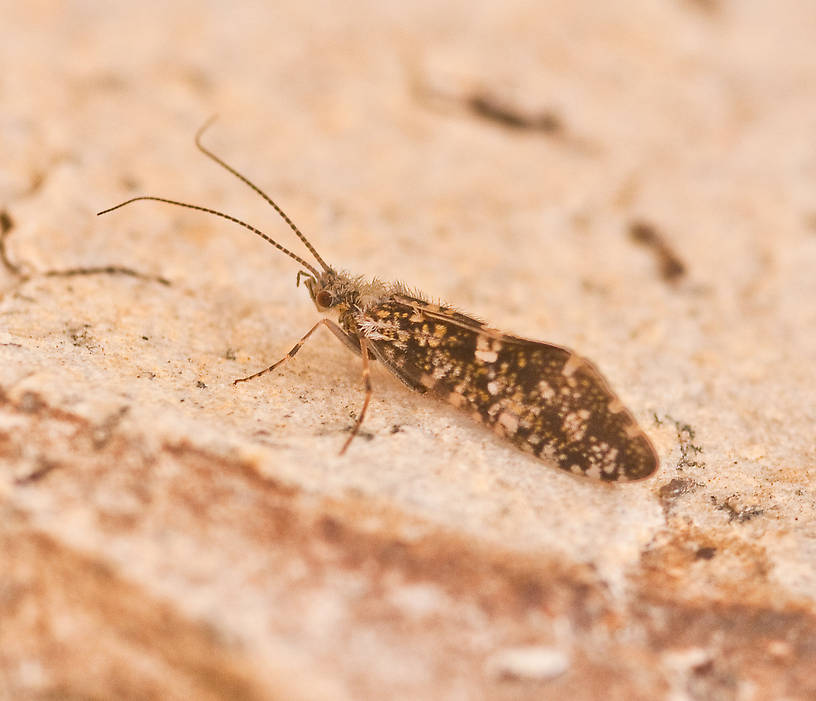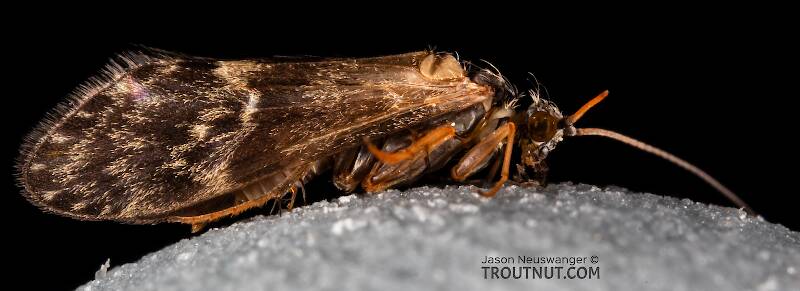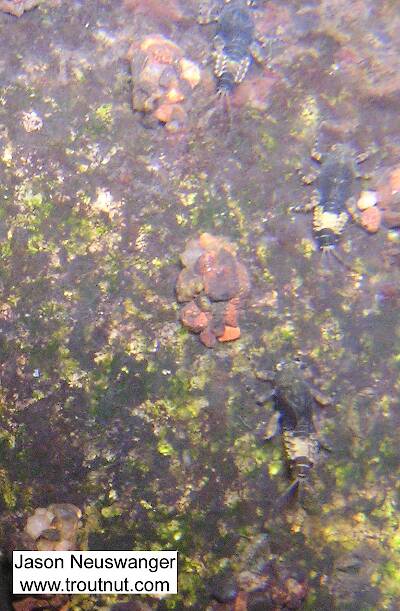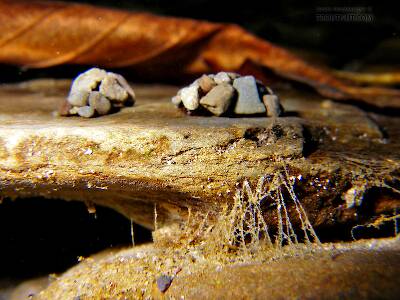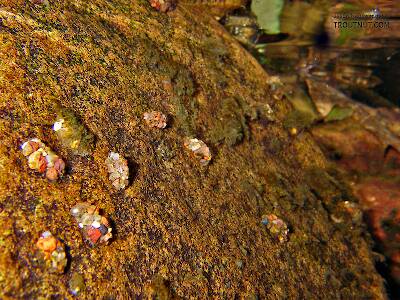
Hex Mayflies
Hexagenia limbata
The famous nocturnal Hex hatch of the Midwest (and a few other lucky locations) stirs to the surface mythically large brown trout that only touch streamers for the rest of the year.
Featured on the forum

Troutnut is a project started in 2003 by salmonid ecologist Jason "Troutnut" Neuswanger to help anglers and
fly tyers unabashedly embrace the entomological side of the sport. Learn more about Troutnut or
support the project for an enhanced experience here.
Caddisfly Family Glossosomatidae (Saddle-case Makers)
This family is one of the primitive caddisflies of the Rhyacophiloidea superfamily. However, they are not free-living like their better known cousins the Rhyacophilidae (Green Rockworm). Instead they build rounded "turtle" shaped cases that do not surround the larvae but are rather attached to the rock surface at their margins. Underneath is a sling made of secretions upon which the larvae ride, hence the common name Saddle-case Makers. There are four genera of possible interest but only one is generally recognized as important to anglers. See Glossosoma (Little Brown Short-horned Caddis) for details. The other three are so tiny that they are also called Pseudo-microcaddis.
Protoptila (Tiny Spotted Short-horned Caddis) is rarely important in trout streams and is generally found in warmer, larger water than the other two genera.
Agapetus (Tiny black Short-horned Caddis) is quite common in many northern streams.
Matrioptila is an extremely tiny southern genus.
Protoptila (Tiny Spotted Short-horned Caddis) is rarely important in trout streams and is generally found in warmer, larger water than the other two genera.
Agapetus (Tiny black Short-horned Caddis) is quite common in many northern streams.
Matrioptila is an extremely tiny southern genus.
Where & when
In 799 records from GBIF, adults of this family have mostly been collected during June (29%), July (25%), May (15%), August (14%), April (7%), and September (5%).
In 255 records from GBIF, this family has been collected at elevations ranging from 3 to 20669 ft, with an average (median) of 1881 ft.
Family Range
Specimens of the Caddisfly Family Glossosomatidae
1 Adult
2 Male Adults
1 Larva

I caught this tiny larva without a case, but it seems to key pretty clearly to to Glossosomatidae. From there, the lack of sclerites on the mesonotum points to either Glossosoma or Anagapetus. Although it's difficult to see in a 2D image from the microscope, it's pretty clear in the live 3D view that the pronotum is only excised about 1/3 of its length to accommodate the forecoxa, not 2/3, which points to Glossosoma at Couplet 5 of the Key to Genera of Glossosomatidae Larvae.
3 Underwater Pictures of Glossosomatidae Caddisflies:
Discussions of Glossosomatidae
Glossosoma intermedium or nigrior
5 replies
Posted by Wiflyfisher on Jun 30, 2020 in the genus Glossosoma
Last reply on Jul 31, 2020 by Creno
pupa color
7 replies
Posted by LittleJ on Apr 19, 2008 in the genus Glossosoma
Last reply on Apr 22, 2008 by LittleJ
Agapetus are EVERYWHERE!!!!
1 replies
Posted by Litobrancha on Apr 12, 2007
Last reply on Apr 12, 2007 by GONZO
Jason
just wanted to spread the word about agapetus. many trout streams have healthy populations of agapetus and there is no reason that some of these species are important to early season emerger/dry fly fishing. small (#18-22) black caddis dry or emerger patterns will mimic them nicely, as well as Dolophilodes Wormaldia and Chimarra.
my colleagues are describing 12 new species of agapetus, mostly from the southeastern united states. i would encourage troutnuts to attempt to collect and rear agapetus pupae. it is pretty easy to do, find pupating cases and remove them from the rocks using forceps and into a small jar of water. If you use a jar with a small amount of water (just a little bit more than required to cover the pupae, removing the small stones around the puparium), then they will pupate in a refrigerator (preferably 60 C or so). Leave the lid loose to allow oxygen to equilibrate with the pupae. This also works for Rhyacophila, which build a similar puparium. We are describing new species of both Agapetus and Rhyacophila and it would be great to have specimens from Troutnuts!!! if interested in doing this, and it is time, email me litobrancha@yahoo.com You can send them to me in alcohol, who knows what else is out there!!!!
just wanted to spread the word about agapetus. many trout streams have healthy populations of agapetus and there is no reason that some of these species are important to early season emerger/dry fly fishing. small (#18-22) black caddis dry or emerger patterns will mimic them nicely, as well as Dolophilodes Wormaldia and Chimarra.
my colleagues are describing 12 new species of agapetus, mostly from the southeastern united states. i would encourage troutnuts to attempt to collect and rear agapetus pupae. it is pretty easy to do, find pupating cases and remove them from the rocks using forceps and into a small jar of water. If you use a jar with a small amount of water (just a little bit more than required to cover the pupae, removing the small stones around the puparium), then they will pupate in a refrigerator (preferably 60 C or so). Leave the lid loose to allow oxygen to equilibrate with the pupae. This also works for Rhyacophila, which build a similar puparium. We are describing new species of both Agapetus and Rhyacophila and it would be great to have specimens from Troutnuts!!! if interested in doing this, and it is time, email me litobrancha@yahoo.com You can send them to me in alcohol, who knows what else is out there!!!!
Start a Discussion of Glossosomatidae
References
- LaFontaine, Gary. 1981. Caddisflies. The Lyons Press.
- Swisher, Doug and Carl Richards. 2000. Selective Trout. The Lyons Press.
Caddisfly Family Glossosomatidae (Saddle-case Makers)
Taxonomy
Genus in Glossosomatidae
Agapetus
0
0
Culoptila
0
0
GlossosomaLittle Brown Short-horned Sedges
4
31
ProtoptilaPseudo-Microcaddisflies
0
0
2 genera (Anagapetus and Padunia) aren't included.



